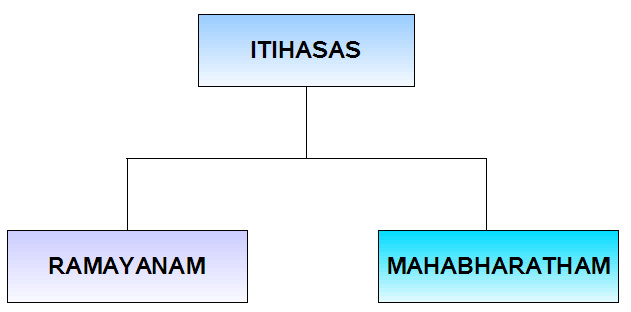Samskruti & Sampradayam
| • | Samskruti |
| • | Sampradayam |
|
INDIA is known to be a “KARMA BHOOMI”. It is The LAND where OUR KARMAS are fulfilled. KARMA is nothing but “Duties” we are supposed to do. The oldest of living religions is based on ancient natural universal law which is known as Sanatana Dharma. Hinduism has embedded the essence of sanatana dharma to form a way of life. Samskruti can be best explained with an example. Hindu Samskruti is very ancient and one of the greatest Samskruties (culture) in the world. Hindu Samskruti has been concealed in “Vedas, Itihasas, Puranas, and Upanishads”. Great sage VYASA MAHARSHI has classified Vedas into 4 categories.  VEDAS
Vedas enlighten us with immense knowledge about various things which we think is impossible to exist or has been invented/discovered in the recent times with the help of science. Vedas provide information regarding the science itself. Our modern equipments or discoveries or inventions like Aeroplane, Test tube babies, Plastic Surgery etc. can be found documented in our ancient literature. Vedas provide details about Measurements and the Posture of the Aeroplane, how the pilot is supposing to act and how well he and the passengers should be seated. “Our great Rishis and Gurus like Dhronacharya, Krupacharya, and the Kouravas" are all test tube Babies. As per Mahabharata they were born in “Earthen pots”. Sage Charaka has done the “plastic surgery” Centuries ago. Vedas have been Sub-divided based on the purpose they serve
UPANISHATHULU “THE ZEST OF THE VEDAS IS STORED IN UPANISHADS”. Upanishads are divided into ”108” out of which 10 are important, they are ESHA, KENA, KATA, PRASHNA, MONDAKA, MANDUKA, TAITREYA, ITAREYA, CHANDHOGYA, BHRUHADARANYAKA. ITIHASAS  The Ramayana consists of 24,000 shlokas written by Sage Valmiki. It depicts the story of Lord Rama and Sita which enables us to understand the relationships and bondage.
The Mahabharata consists of 18 Parvas and 1 lakh shlokas written by Vyasa Maharishi. The Mahabharata is also known as the PANCHAMA VEDAM which depicts Neeti Shastram. The Mahabharata has given us the precious Gifts like BHAGAVAD GEETA and VISHNUSAHASRANAMAM. PURANAS The Puranas are 18 different stories which has been simplified and written so that we can under stand and lead our life in a proper way (Dharma baddhanga) and it even explains us about the rituals that we are supposed to perform and the works that we are supposed to do as Humans, and gives knowledge about the importance of piligrimage. The 18 Puranas are 1. BRAMHA PURANAM, 2. PADMA PURANAM, 3. VISHNU PURANAM 4. SHIVA PURANAM 5. BHAGAVATHAM 6. LINGA PURANAM 7. VARAHA PURANAM 8. NARADHIYA PURANAM 9. MARKANDEYA PURANAM 10. AGNI PURANAM 11. BHAVISHYA PURANAM 12. BRAMHAVAIVARTHA PURANAM 13. SKANDHA PURANAM 14. VAMANA PURANAM 15. KURMA PURANAM 16. MASTHYA PURANAM 17. GARUDA PURANAM 18. BRAMHANDA PURANAM The Bhagavath Geeta is considered as the Gift to the world by Sri Krishna. Samskaras
They are nothing but the rituals and sacrifices,These rituals cover the entire life of an hindu, from the time of conception to the funeral ceremonies and there after. The samskaras are given (done) mainly in two forms “Mantras and Mudras’’ which are disclosed when ever it is needed. The samskaras are of 16 which are also known as Sodasha karmas...
Samskaras also create the cultural and traditional awareness, for instance when the boy is given the scared thread “upanayanam”, he is given the right to study the Vedas and perform certain duties as 'Bhramachari' after the marriage the 'Gruhasta' is given the right to perform the rituals mentioned in the Vedas. In short the samskaras are so well designed by our ancestors that it covers the entire social and spiritual life of a person. The samskaras in other words can be explained as the process of purification of the soul from the influence of worldly life towards attaining the moksha. SAMPRADHAYAM Sampradayam is nothing but the traditions adopted and followed. The Hindu Sampradayam is very vast and as deep as an ocean. It can be best expressed as “Unity in Diversity”. Let us start with the Festivals and then proceed towards Music and Dance etc. |